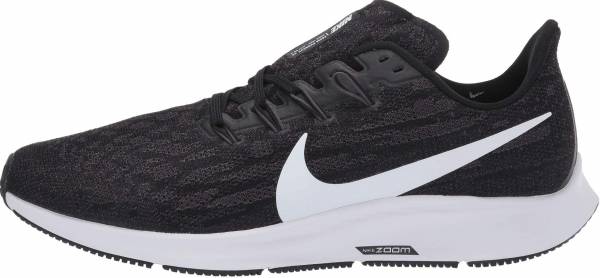Facts
| Terrain: | Road |
|---|---|
| Arch support: | Neutral |
| Use: | Jogging |
| Weight: | Men: 283g | Women: 227g |
| Heel to toe drop: | Men: 10mm | Women: 10mm |
| Pronation: | Neutral Pronation |
| Arch type: | High arch |
| Strike Pattern: | Heel strike |
| Distance: | Daily running | Long distance | Marathon |
| Heel height: | Men: 28mm | Women: 29mm |
| Forefoot height: | Men: 18mm | Women: 19mm |
| Release date: | Jun 2019 |
| Brand: | Nike |
| Width: | Men: Normal, Wide, X-Wide | Women: Normal, Wide |
| Price: | €150 |
| Colorways: | Green, Pink, Black, Grey, Red, Silver, White, Blue, Multi |
| Special editions: | 4 special editions |
Rankings
Expert Reviews
Experts are runners, who post reviews at youtube, directly at RunRepeat or at their own websites. Each expert is categorized from level 1 to level 5 based on expertise. See stats on expert reviews and how we calculate scores here.
Are you an expert? Apply to contribute here.
88 / 100 based on 15 expert reviews
-
Nike Air Zoom Pegasus 36 – Good all-rounders, with one fatal flaw
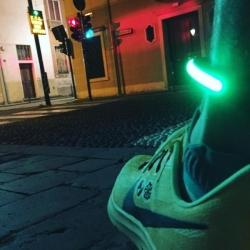
 More photos
More photos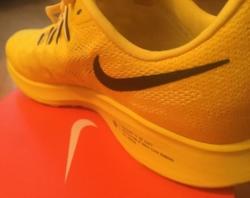
In running, as in fine dining, the first taste is with the eye.
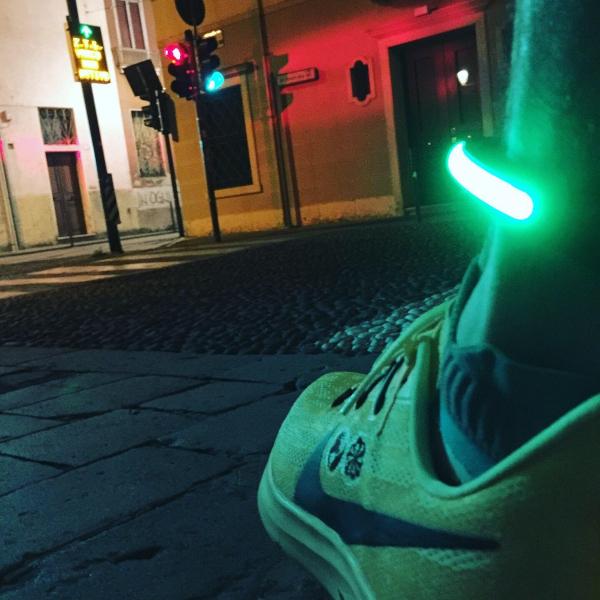
The banana-yellow of these shoes shoots right to the back of your retina and kicks you in the optic nerve. Meanwhile, the big black swoosh overlay adds a touch of danger, like a bee or a particularly miffed snake.
You don’t know whether to eat these shoes or hide from them. All these say that visual design is at the forefront of this edition of Nike Pegasus.
And rightly so, the designer and Artist In Residence (A.I.R), Cody Hudson, has done a stand-up job of creating a striking and clean look in a market of shoes.
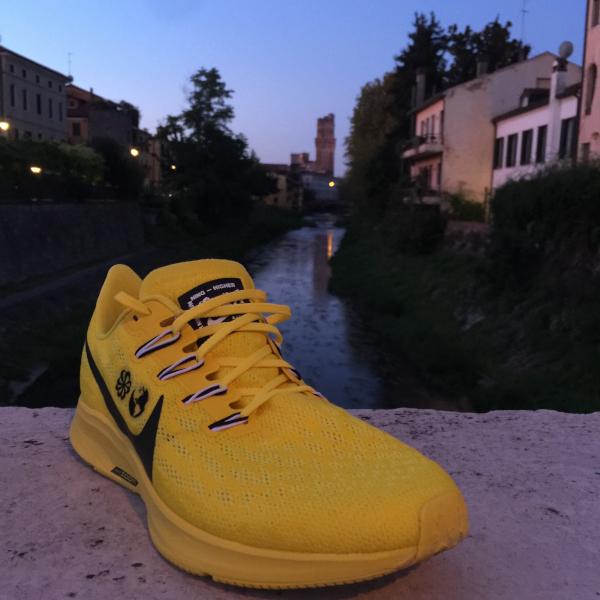
Casually slipping them on, I was first surprised by the amount of freedom allowed in the heel. The back of my foot was moving a few millimetres and creating friction.
I quickly learned that’s because I did it wrong.To wear these shoes, you have to take extreme care to lace them up tight. Pulling from the bottom of the laces, threading the tension up through each eyelet, and tightly tying creates an ultra-snug, 360-degree supportive fit—a chrysalis for your feet.
No more heel slippage. Once laced firmly, they are a second skin.
Lifting my heels, they felt light and responsive, if a little stiff. That was all to change once I had tried them on the road.
But, I’m getting ahead of myself. Let’s look at the details of the shoe first.

The upper
The engineered mesh upper provides solid support around the whole of the forefoot. Still, crucially its mild elasticity allows just enough movement and give to avoid this turning into undue restriction.
There are an external layer and a soft inner sock-liner — both heavily perforated to create the feeling of a wind tunnel for the toes.
While the fit can feel restrictive on first wear (particularly in the toe box), after a few minutes of training, the upper expands to give a tight but accommodating fit.
The exposed flywire cord assisted lacing system— lateral tethers stretching from the eyelets on each side and anchoring solidly down into the midsole—greatly aided this.
These transfer the tension from the laces and distribute it evenly around the midfoot. It gives your feet a reassuring hug and enhancing the feeling of ergonomic ‘oneness’ — that these are less an external accessory than an extension of your body.
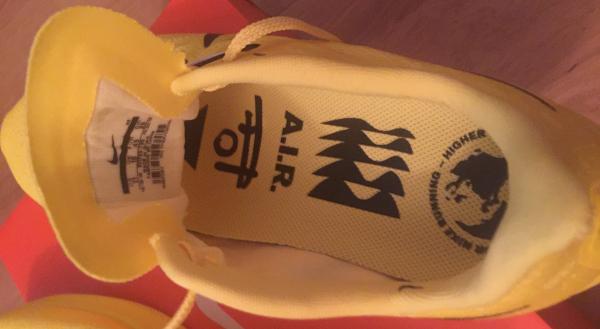
The tongue is asymmetrical and very skinny — no bloated plushness here. The shape serves to mould to the bridge of your foot as discreetly as possible, maintaining a streamlined form.
There is a downside to the tongue design, however, which I will touch on a little later.
The insoles feature more black silhouettes akin to those on the upper, which I can only guess would represent: a flower, the world, a pyramid, a swoosh, a picture of an old fence and a stack of dishes.
Additionally, one insole bears the perplexing legend: "DRONE — ZONE — MIND — BODY — BREATHE — DEEP." with every other letter printed upside-down and back to front.
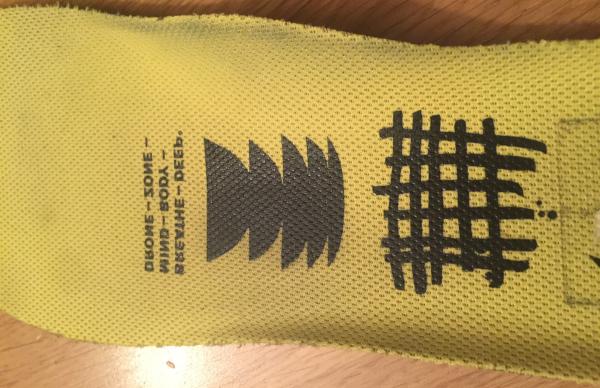
While this may contain some profound meaning, I’ll leave that for you to ponder on a particularly long, slow run.
The insole provides some pleasing extra cushioning, especially in the heel. Not much in the way of arch support in these shoes, so neutral runners will be best served.
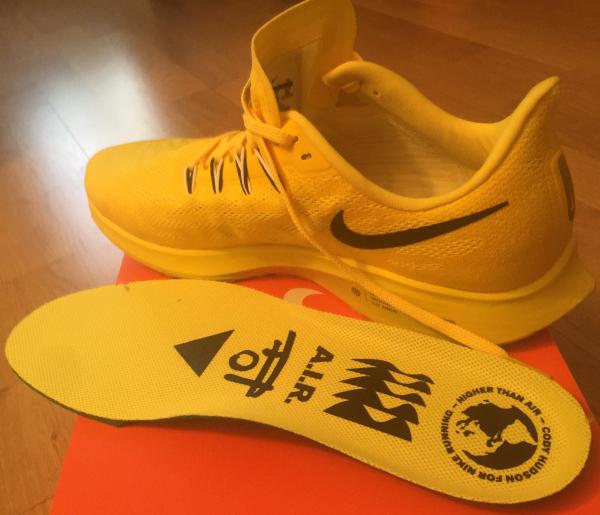
The only plush part of the upper is the heel collar, which tapers away at the Achilles tendon. It gives plenty of freedom from the ankle upwards for uneven or undulating terrain as well as fast downhills.
The support of the padded collar adds to the wearability of these shoes and creates a comfortable seal to the unit. Also, I have experienced no friction issues or restriction of motion.
I have one, quite major, gripe with the upper , and it's one of the first things I noticed about the shoe— the lacing system. Yes, you must tie them tight, or they come loose. But, not too tight or they come loose.
Lacing them is more an art than a science. Nike’s choice of a very thin, flat tongue means there isn’t that buffer between the lace knot and the bridge of the foot that a plush tongue provides.
Thus, every vertical movement of the foot transfers directly as pressure on the knot and any weakness in the knot will work itself loose over time.
These are the only shoes I have had come undone while training, which makes me think twice about wearing them on a race day.
I’ve had the most success by tying the knot very tightly, but incorporating the slightest gap between the knot and the tongue, so the knot is sitting on the resting foot rather than being pulled against it.
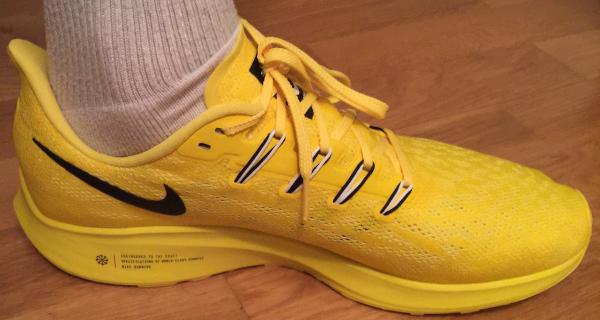
Midsole
A full-length Air pocket and proprietary Cushlon foam make up the midsole of the Peg 36.
The ride feels a little stiff at first. But, after the first few minutes of training, the shoes warm up and melt deliciously underfoot providing ligament-friendly cushioning while remaining responsive and flexible.
The 10mm drop adds an extra push to your pace when tempo running, and the heel-to-toe transition is slick and smooth.
At slower tempos, I find the ride a little jarring, owing to a tendency to heel strike at these paces. But, once I pick up the speed, there is a real feel of ease, fluidity, and circularity of motion, like running in an invisible hamster wheel.
As well as road running, I’ve also tried these on some tamer tracks. They cope as well as can be expected for a road shoe—remaining stable on uneven ground and minor obstacles like exposed tree roots.
After only a few kilometres, I found that the heel had visibly crumpled and was at first a little concerned. But, after 200+ km in these shoes, the crumpling has not worsened, and the midsole has remained soft and responsive as ever.
The widths available are D (regular — my review size), 2E (wide) and 4E (extra wide). I have a narrow foot, and the D was a perfect fit, but it could easily be too skinny for some.
Outsole
Waffled carbon rubber makes up the outsole, and it is resilient indeed. After a month of heavy training in these, I have visible wear only on the very frontmost ‘waffle’.

The profile of the outsole enhances the feeling of fluidity of this shoe, and particularly the tapered rear, which ensures your heel meets the road smoothly with each step at speed.
There is plenty of tread on the outsole to deal with roads and paths with aplomb. However, I wouldn’t use them for anything more technical than a gravel path or tame woodland as the grip is geared towards smoother surfaces.
A full-length heel-to-toe groove creates a remarkably fluid transition on road surfaces and makes the shoe feel a lot more flexible than it is when taken in hand.
This is a big plus over longer distances as it evokes a feeling of effortlessness that is even palpable on tired legs.
In conclusion
Pros
- Stylish as heck
- Slick, cushioned, and speedy ride
- Quite lightweight
- Comfortable, firm but unrestrictive fit
- Well-ventilated
- Not unreasonably priced, for the market
Cons
- The laces could betray you on a race day
- Little support for overpronators
- A bumpy ride on slow runs
On balance, I give this shoe an 85/100. An excellent all-rounder and ideal for tempo training, but there are better options for slow, long runs as well as race days.
This expert has been verified by RunRepeat. Reviews are neutral, unbiased and based on extensive testing.
-
Nike Zoom Pegasus 36 after 100 miles
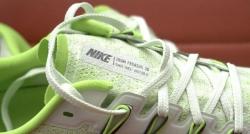
 More photos
More photos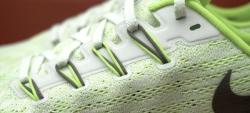
The shoe presents a quality feel when first placing your foot within the upper. This 2019 update to the Pegasus line has a more minimal feel to last year's offering.
The tongue is less obtrusive than the longer, stretched out tongue found on the Pegasus 35. I never had an issue with the tongue on that version of the shoe.
It is certainly not detectable here and does the job of protecting the forefoot from the laces perfectly.
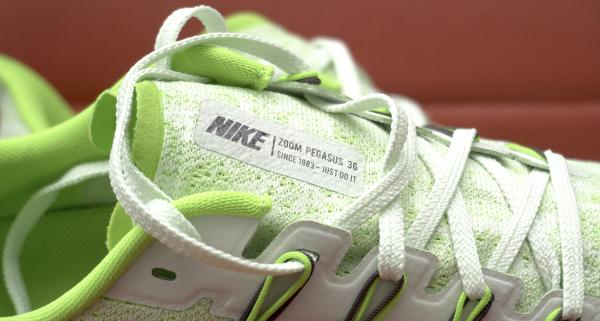
The tongue is also thinner and slightly offset around the ankle area, which helps with some of the weight relief I shall discuss later.
I do note that after 100 miles, the very edge of the tongue shows some light fraying. But, it is only aesthetic wear and doesn't cause any discomfort.
The upper is made from an engineered mesh that features a booty type construction. It wraps around the foot and provides an enjoyable level of comfort.
The shoe uses flywires wherein the laces pass through to assist with lockdown.
And, amongst my runs in the shoe, I have experienced no problems in getting an appropriate level of fit using this system, both quickly and consistently.
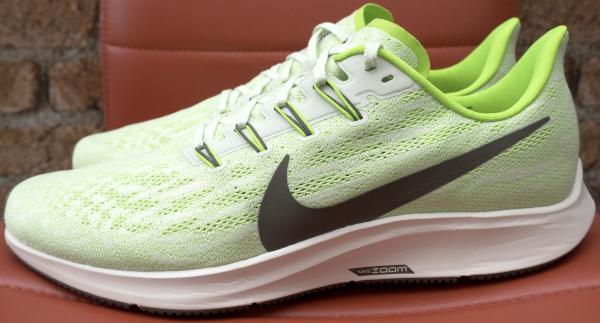
The upper is an improvement from the Pegasus 35. I feel it is more breathable and lighter, which is ideal for daily trainer within warmer temperatures.
However, it could present issues when running in colder conditions.
Often overlooked is the quality of laces. These have enough of a tactile feel to them to stop them coming undone when rubbing together over the miles.
A thin plastic overlay is present to reinforce the lace eyelets. Also, a welcome inclusion is an extra setback eyelet towards the ankle for employing a runner's knot.
Although with this shoe, I did di not see a need for this extra eyelet due to the improved lockdown over the forefoot.
That aside, it is a welcome addition and one that provides flexibility for runners with differing foot widths and volumes.
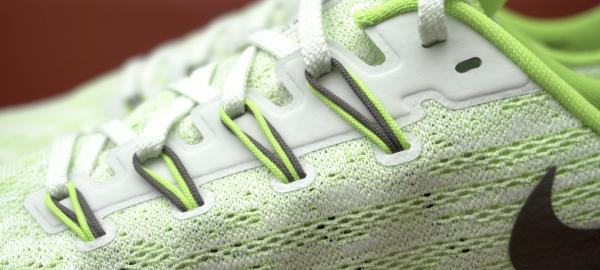
The shoe fits me true to size. I am a UK size 11, and the shoe has ample room in the forefoot area and good heel cup lock.
One minor negative, which is purely aesthetic, is that the mesh of the shoe attracts dirt quickly. Thus, the shoe is hard to clean using conventional methods.
My green version of the shoe has quickly tarnished and already looks well-used.
Midsole and outsole
There are no changes to the outsole or midsole pattern from the previous iteration of the shoe. So, if you are a fan of this arrangement, then you won't be disappointed.
The midsole features a full-length Zoom Air pocket underfoot. This pocket provides ample cushioning for runners with a neutral foot strike.
From previous experience, I have found the Zoom Air pocket begins to bottom out around 240 miles. My pair of Pegasus 35 that has around 250 miles of use show typical signs of this wear.
The midsole has begun to crease at 100 miles of use similarly to the older model. The Zoom Air pocket still feels full of life and remains responsive at this point.
The outsole features a hexagonal pattern, which starts with smaller lugs at the forefoot. These lugs become more stretched as you approach the heel area of the shoe.
The outer side of the outsole has a crash area, which helps to provide stability if the foot strikes away from the midfoot.
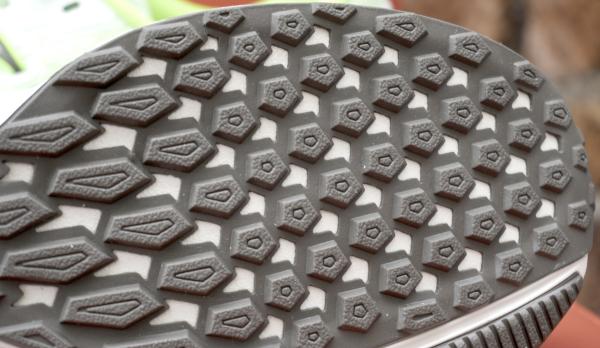
I have taken the shoe for a range of runs on various surfaces. I found it to be a good all-round shoe. It only really struggled on very muddy areas, which, of course, it is not designed for.
On road or pavement, it shines and has good traction. Even some light trails are negotiable with this shoe. It falls into the “middle of the road” category, which is nothing to be ashamed of.
At around 100 miles, I see only minimal wear to the outsole. There is some light wear on the outsole nubs around the higher forefoot area.
There is also very slight wear on the outer side of the heel on both shoes in almost identical areas.
Weight
A UK size 11 or US 12 weighs in around 290g or 10.2oz. It is not the lightest of shoes but features appropriate levels of cushioning for daily training.
That aside, there are lighter options out there within this popular category such as the New Balance Beacon V1, which are becoming more scarce in supply at the time of writing.
The weight saving seems to come from the lighter upper, which is still ample in terms of strength. The other weight saving comes from the less padded tongue and heel cup area.
There are race targeted offerings from Nike, Adidas, and New Balance, but all of higher cost. These also won't work so well for mixed training and recovery portions of interval work.
Price & Value
At around £104 to £88, the shoe shows good signs of value. However, this will depend on the type of training activities you will be using it for.
It is a great choice for those looking for a daily shoe that will perform well for most activities, even for local racing. I believe this shoe to be at a good value, performance and price point.
Moreover, I recommend it to many runners of varying ability and weekly mileage.
I expect at least another 150 miles from this shoe before the midsole foam becomes overly compressed and the air unit begins to lose its initial bounce.
Hence, it would be a similar number of miles that I achieved from the previous version of the shoe.
Possible usage for the shoe
I have found that the Pegasus 36 has fallen into the category of daily shoe. It is for those mid-paced runs around 7:45 to 8:00 per mile and easy recovery miles.
That aside, I have worn the shoe for more extensive sessions of up to 10 miles. Even though it performed well, I would not recommend it above this.
It is because I could feel the midsole starting to bottom out around this type of mileage. Nonetheless, I have used the shoes for all manner of different training activities.
Ultimately, it does shine for mid-paced runs or easy recovery type miles. This is mainly due to the comfort of the upper and the cushioned and responsive nature of the midsole.
One can achieve higher paces with this shoe. Although, I found more effort was required to reach these within the Pegasus 36 than other shoes of similar ilks.
An example would be the New Balance Beacon 1. The Beacon is a little lighter though it has a more basic and less detailed feel inside the shoe.
I would suggest that the Beacon can handle higher paces with less effort than the Pegasus 36.
Overall
The shoe is an improvement of the previous version. It improved in terms of a slightly lighter upper and thinner but just as effective tongue.
It also has the same workhorse midsole and outsole as before.
The only negative in terms of performance is that the shoe could be slightly lighter or similar in weight to some other models in its category.
If so, making faster paces would be somewhat easier to achieve. Regardless, this is an improvement on the previous iteration in terms of all the changes that have been made.
Overall, I would recommend it to a variety of runners looking for a shoe from this type of category.
This expert has been verified by RunRepeat. Reviews are neutral, unbiased and based on extensive testing.
-
Overall, just really enjoying my time with the Pegasus 36.
-
Personally, I like this shoe a little bit less than the 35.
- The Nike Air Zoom Pegasus 36 is an update to a highly regarded series of running shoes. The design of this updated model sticks closely to its immediate predecessor, the Pegasus 35, though it shaves off bulk by having a slimmer upper design and lesser padding in the heel collar and tongue unit.
- Additional micro-perforations grace the silhouette, and they’re meant to encourage more air into the foot-chamber. The open construction of the upper calls for a sturdier overlay system on the instep to prevent the shoelaces from cutting through the fabric.
The Nike Air Zoom Pegasus 36 was made using the regular measurements. The sizing scheme aims to follow the usual expectations of consumers, so choosing the typical options would most likely be alright. Widthwise, the available options are D – Medium and B – Medium for men and women, respectively.
It is worth noting that several people had complained of an in-shoe experience that was tight. Such concerns may be alleviated by testing other size options or observing user feedback from comments sections of product pages.
The forefoot section of the Nike Air Zoom Pegasus 36’s outsole unit is made of Duralon, a blown rubber compound that is traction-ready yet spongy enough to warrant some extra cushioning for the foot. Angled lugs heighten the gripping capacity of the shoe, thereby giving precise surface control at all times.
BRS 1000 is carbon rubber, and it is used as the material for the heel part of the external pad. This layer protects against impact shock and surface abrasion. It also has a grippy nature to allow for sound and confident steps.
The Crash Rail is a tread-pattern on the lateral side of the sole unit. This design involves shallow flex grooves and horizontal lines that serve as transition points for the foot as it glides through the gait cycle.
Cushlon is the primary cushioning unit of the Nike Air Zoom Pegasus 36. This full-length piece is designed to carry the foot throughout the running session, keeping it cushioned as it is standing idly or taking each step. It has also been configured to last long.
Zoom Air is a plastic cassette that is filled with air. This bubble-like technology runs the entire length of the shoe, encompassing the whole foot. Its job is to enhance the reactive and bouncy nature of the platform, as well as to help with impact attenuation. The air-filled container itself isn’t stiff or heavy.
A resilient yet flexible sock liner is placed right above the main foam unit. This add-on is tasked with providing a bit more oomph to the underfoot experience. It has a curved structure that cradles the arch, a structure of the foot that isn’t usually given attention. It can be removed or replaced with a new one.
The upper unit of the Nike Air Zoom Pegasus 36 is made of engineered mesh. This textile has a stretchy and seamless configuration, which makes it similar to the material that’s used for clothes. The form-accommodating nature allows it to adapt to the natural swelling and bending of the foot as it transitions from the heel to the toe during the run. The breathing holes that pockmark its surface bring a cool and dry in-shoe environment.
The cover system has a low profile which allows the fabrics to hug the foot securely and to prevent positional deviation.
Synthetic prints adorn the instep of this road running shoe. These thin yet sturdy overlays reinforce the eyelets of the lacing system, saving the fabrics from tearing apart due to the crisscrossing shoestrings.
The dynamic Flywire cables are stretchy wires that jut out from the sides of the silhouette. These strands are designed to help the lacing system when it comes to locking the foot in place. They act as extra sets of eyelets, with the shoelaces looping through them as well. Tightening or loosening the fit would cause the Flywires to react and join the adjustment.
The padded collar has the job of cushioning the heel and the ankles. This curved wall also protects the foot from wobbling or exiting the interior of the shoe unexpectedly.
The lightly padded yet flat-edged tongue unit follows the outline of the foot’s bridge. This accoutrement of the upper protects the skin from getting chafed by the intersecting shoelaces while also contributing to the overall quality of the fit.
A strip of reflective material is put on the back part of the upper unit. This small capsule-shaped adornment makes the shoe more visible in low-light. Runners who like to run at night are the ones who are likely to enjoy this safety feature.
Nike Air Zoom Vomero
The Air Zoom Vomero line of running shoes is one of Nike’s most beloved. People have flocked to this roster because they felt that the models within it are superbly crafted and impeccably designed. The façades of these shoes are known for their colorful hues and inviting looks. They look sporty, but they’re far from being strictly made for running. The Vomeros also have Zoom Air in them, but there are two of these cassettes instead of a full-length piece like in the Pegasus line, and they’re placed in the forefoot and heel.
Nike Air Zoom Structure
Overpronation is a concern that plague many runners. The irregular rolling in of the foot as it takes each step can be detrimental to the quality of the run or the anatomy of the runner’s lower extremities. Nike’s means of addressing such troubles is its family of stability running shoes and the anti-pronation elements that come with them. The designs of these steadying mechanisms aren’t too overdone or obnoxious because the company still desires their shoes to be versatile enough to be used by neutral pronators as well. An example series is the Air Zoom Structure, which employs a dense midfoot feature called Dynamic Support that averts excessive inward rolling but doesn’t make itself too prominent.







